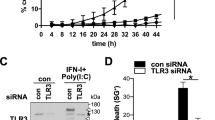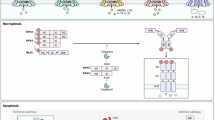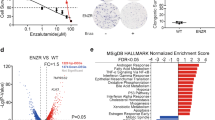Abstract
Apoptosis occurs through a tightly regulated cascade of caspase activation. In the context of extrinsic apoptosis, caspase-8 is activated by dimerization inside a death receptor complex, cleaved by auto-proteolysis and subsequently released into the cytosol. This fully processed form of caspase-8 is thought to cleave its substrates BID and caspase-3. To test if the release is required for substrate cleavage, we developed a novel approach based on localization probes to quantitatively characterize the spatial-temporal activity of caspases in living single cells. Our study reveals that caspase-8 is significantly more active at the plasma membrane than within the cytosol upon CD95 activation. This differential activity is controlled by the cleavage of caspase-8 prodomain. As a consequence, targeting of caspase-8 substrates to the plasma membrane can significantly accelerate cell death. Subcellular compartmentalization of caspase-8 activity may serve to restrict enzymatic activity before mitochondrial pathway activation and offers new possibilities to interfere with apoptotic sensitivity of the cells.
Similar content being viewed by others
Log in or create a free account to read this content
Gain free access to this article, as well as selected content from this journal and more on nature.com
or
Abbreviations
- DISC:
-
death-inducing signaling complex
- BID:
-
BH3-interacting death agonist
- MOMP:
-
mitochondrial outer membrane permeabilization
- NES:
-
nuclear export signal
- Myr–Palm:
-
myristoylation–palmitoylation
- ER:
-
endoplasmic reticulum
- LZ-sCD95L:
-
leucine zipper-soluble CD95 ligand
- mGFP:
-
monomeric green fluorescent protein
- YFP:
-
yellow fluorescent protein
- EBFP2:
-
enhanced blue fluorescent protein 2
- XIAP:
-
X-linked inhibitor of apoptosis protein
- FRET:
-
fluorescence resonance energy transfer
- DMEM:
-
Dulbecco’s modified eagle medium
- LSCM:
-
laser scanning confocal microscope
References
Degterev A, Boyce M, Yuan J . A decade of caspases. Oncogene 2003; 22: 8543–8567.
Grutter MG . Caspases: key players in programmed cell death. Curr Opin Struct Biol 2000; 10: 649–655.
Siegel RM . Caspases at the crossroads of immune-cell life and death. Nat Rev Immunol 2006; 6: 308–317.
Fuentes-Prior P, Salvesen GS . The protein structures that shape caspase activity, specificity, activation and inhibition. Biochem J 2004; 384 (Pt 2): 201–232.
Boatright KM, Renatus M, Scott FL, Sperandio S, Shin H, Pedersen IM et al. A unified model for apical caspase activation. Mol Cell 2003 2003/2 11: 529–541.
van Raam BJ, Salvesen GS . Proliferative versus apoptotic functions of caspase-8 Hetero or homo: the caspase-8 dimer controls cell fate. Biochim Biophys Acta 2012; 1824: 113–122.
Kischkel FC, Hellbardt S, Behrmann I, Germer M, Pawlita M, Krammer PH et al. Cytotoxicity-dependent APO-1 (Fas/CD95)-associated proteins form a death-inducing signaling complex (DISC) with the receptor. EMBO J 1995; 14: 5579–5588.
Boldin MP, Goncharov TM, Goltsev YV, Wallach D . Involvement of MACH, a novel MORT1/FADD-interacting protease, in Fas/APO-1- and TNF receptor-induced cell death. Cell 1996; 85: 803–815.
Muzio M, Chinnaiyan AM, Kischkel FC, O’Rourke K, Shevchenko A, Ni J et al. FLICE, a novel FADD-homologous ICE/CED-3-like protease, is recruited to the CD95 (Fas/APO-1) death--inducing signaling complex. Cell 1996; 85: 817–827.
Scaffidi C, Fulda S, Srinivasan A, Friesen C, Li F, Tomaselli KJ et al. Two CD95 (APO-1/Fas) signaling pathways. EMBO J 1998; 17: 1675–1687.
Wachmann K, Pop C, van Raam BJ, Drag M, Mace PD, Snipas SJ et al. Activation and specificity of human caspase-10. Biochemistry 2010; 49: 8307–8315.
Hughes MA, Harper N, Butterworth M, Cain K, Cohen GM, MacFarlane M . Reconstitution of the death-inducing signaling complex reveals a substrate switch that determines CD95-mediated death or survival. Mol Cell 2009; 35: 265–279.
Keller N, Mares J, Zerbe O, Grutter MG . Structural and biochemical studies on procaspase-8: new insights on initiator caspase activation. Structure 2009; 17: 438–448.
Oberst A, Pop C, Tremblay AG, Blais Vr, Denault J-B, Salvesen GS et al. Inducible dimerization and inducible cleavage reveal a requirement for both processes in caspase-8 activation. J Biol Chem 2010; 285: 16632–16642.
Kang TB, Oh GS, Scandella E, Bolinger B, Ludewig B, Kovalenko A et al. Mutation of a self-processing site in caspase-8 compromises its apoptotic but not its nonapoptotic functions in bacterial artificial chromosome-transgenic mice. J Immunol 2008; 181: 2522–2532.
Keller N, Grutter MG, Zerbe O . Studies of the molecular mechanism of caspase-8 activation by solution NMR. Cell Death Differ 2010; 17: 710–718.
Golks A, Brenner D, Schmitz I, Watzl C, Krueger A, Krammer PH et al. The role of CAP3 in CD95 signaling: new insights into the mechanism of procaspase-8 activation. Cell Death Differ 2006; 13: 489–498.
Martin DA, Siegel RM, Zheng L, Lenardo MJ . Membrane oligomerization and cleavage activates the caspase-8 (FLICE/MACHalpha1) death signal. J Biol Chem 1998; 273: 4345–4349.
Koenig A, Russell JQ, Rodgers WA, Budd RC . Spatial differences in active caspase-8 defines its role in T-cell activation versus cell death. Cell Death Differ 2008; 15: 1701–1711.
Gonzalvez F, Schug ZT, Houtkooper RH, MacKenzie ED, Brooks DG, Wanders RJ et al. Cardiolipin provides an essential activating platform for caspase-8 on mitochondria. J Cell Biol 2008; 183: 681–696.
Schug ZT, Gonzalvez F, Houtkooper RH, Vaz FM, Gottlieb E . BID is cleaved by caspase-8 within a native complex on the mitochondrial membrane. Cell Death Differ 2011; 18: 538–548.
Kantari C, Walczak H . Caspase-8 and bid: caught in the act between death receptors and mitochondria. Biochim Biophys Acta 2011; 1813: 558–563.
Strasser A, Jost PJ, Nagata S . The many roles of FAS receptor signaling in the immune system. Immunity 2009; 30: 180–192.
Granell S, Baldini G, Mohammad S, Nicolin V, Narducci P, Storrie B . Sequestration of mutated alpha1-antitrypsin into inclusion bodies is a cell-protective mechanism to maintain endoplasmic reticulum function. Mol Biol Cell 2008; 19: 572–586.
Wiley SE, Murphy AN, Ross SA, van der Geer P, Dixon JE . MitoNEET is an iron-containing outer mitochondrial membrane protein that regulates oxidative capacity. Proc Natl Acad Sci USA 2007; 104: 5318–5323.
Chen Y, MacDonald PJ, Skinner JP, Patterson GH, Muller JD . Probing nucleocytoplasmic transport by two-photon activation of PA-GFP. Microsc Res Tech 2006; 69: 220–226.
Wei X, Henke VG, Strubing C, Brown EB, Clapham DE . Real-time imaging of nuclear permeation by EGFP in single intact cells. Biophys J 2003; 84 (2 Pt 1): 1317–1327.
Albeck JG, Burke JM, Aldridge BB, Zhang M, Lauffenburger DA, Sorger PK . Quantitative analysis of pathways controlling extrinsic apoptosis in single cells. Mol Cell 2008; 30: 11–25.
Stennicke HR, Renatus M, Meldal M, Salvesen GS . Internally quenched fluorescent peptide substrates disclose the subsite preferences of human caspases 1, 3, 6, 7 and 8. Biochem J 2000; 350 (Pt 2): 563–568.
Micheau O, Tschopp J . Induction of TNF receptor I-mediated apoptosis via two sequential signaling complexes. Cell 2003; 114: 181–190.
Tchikov V, Bertsch U, Fritsch J, Edelmann B, Schutze S . Subcellular compartmentalization of TNF receptor-1 and CD95 signaling pathways. Eur J Cell Biol 2011; 90: 467–475.
Boya P, Kroemer G . Lysosomal membrane permeabilization in cell death. Oncogene 2008; 27: 6434–6451.
Caruso JA, Mathieu PA, Joiakim A, Zhang H, Reiners JJ . Aryl hydrocarbon receptor modulation of tumor necrosis factor-alpha-induced apoptosis and lysosomal disruption in a hepatoma model that is caspase-8-independent. J Biol Chem 2006; 281: 10954–10967.
Heinrich M, Neumeyer J, Jakob M, Hallas C, Tchikov V, Winoto-Morbach S et al. Cathepsin D links TNF-induced acid sphingomyelinase to Bid-mediated caspase-9 and -3 activation. Cell Death Differ 2004; 11: 550–563.
Cowling V, Downward J . Caspase-6 is the direct activator of caspase-8 in the cytochrome c-induced apoptosis pathway: absolute requirement for removal of caspase-6 prodomain. Cell Death Differ 2002; 9: 1046–1056.
Inoue S, Browne G, Melino G, Cohen GM . Ordering of caspases in cells undergoing apoptosis by the intrinsic pathway. Cell Death Differ 2009; 16: 1053–1061.
Slee EA, Adrain C, Martin SJ . Executioner caspase-3, -6, and -7 perform distinct, non-redundant roles during the demolition phase of apoptosis. J Biol Chem 2001; 276: 7320–7326.
Slee EA, Harte MT, Kluck RM, Wolf BB, Casiano CA, Newmeyer DD et al. Ordering the cytochrome c-initiated caspase cascade: hierarchical activation of caspases-2, -3, -6, -7, -8, and -10 in a caspase-9-dependent manner. J Cell Biol 1999; 144: 281–292.
Deveraux QL, Takahashi R, Salvesen GS, Reed JC . X-linked IAP is a direct inhibitor of cell-death proteases. Nature 1997; 388: 300–304.
Klaiman G, Champagne N, LeBlanc AC . Self-activation of Caspase-6 in vitro and in vivo: caspase-6 activation does not induce cell death in HEK293T cells. Biochim Biophys Acta 2009; 1793: 592–601.
Wang XJ, Cao Q, Liu X, Wang KT, Mi W, Zhang Y et al. Crystal structures of human caspase 6 reveal a new mechanism for intramolecular cleavage self-activation. EMBO Rep 2010; 11: 841–847.
Albeck JG, Burke JM, Spencer SL, Lauffenburger DA, Sorger PK . Modeling a snap-action, variable-delay switch controlling extrinsic cell death. PLoS Biol 2008; 6: 2831–2852.
Dickens LS, Boyd RS, Jukes-Jones R, Hughes MA, Robinson GL, Fairall L et al. A death effector domain chain disc model reveals a crucial role for caspase-8 chain assembly in mediating apoptotic cell death. Mol Cell 2012; 47: 291–305.
Schleich K, Warnken U, Fricker N, Ozturk S, Richter P, Kammerer K et al. Stoichiometry of the CD95 death-inducing signaling complex: experimental and modeling evidence for a death effector domain chain model. Mol Cell 2012; 47: 306–319.
Lee KH, Feig C, Tchikov V, Schickel R, Hallas C, Schutze S et al. The role of receptor internalization in CD95 signaling. EMBO J 2006; 25: 1009–1023.
Jin Z, Li Y, Pitti R, Lawrence D, Pham VC, Lill JR et al. Cullin3-based polyubiquitination and p62-dependent aggregation of caspase-8 mediate extrinsic apoptosis signaling. Cell 2009; 137: 721–735.
Hellwig CT, Kohler BF, Lehtivarjo AK, Dussmann H, Courtney MJ, Prehn JH et al. Real time analysis of tumor necrosis factor-related apoptosis-inducing ligand/cycloheximide-induced caspase activities during apoptosis initiation. J Biol Chem 2008; 283: 21676–21685.
Rehm M, Dussmann H, Janicke RU, Tavare JM, Kogel D, Prehn JHM . Single-cell fluorescence resonance energy transfer analysis demonstrates that caspase activation during apoptosis is a rapid process. J Biol Chem 2002; 277: 24506–24514.
Rehm M, Huber HJ, Dussmann H, Prehn JH . Systems analysis of effector caspase activation and its control by X-linked inhibitor of apoptosis protein. EMBO J 2006; 25: 4338–4349.
Reichenzeller M, Burzlaff A, Lichter P, Herrmann H . In vivo observation of a nuclear channel-like system: evidence for a distinct interchromosomal domain compartment in interphase cells. J Struct Biol 2000; 129: 175–185.
Beaudouin J, Gerlich D, Daigle N, Eils R, Ellenberg J . Nuclear envelope breakdown proceeds by microtubule-induced tearing of the lamina. Cell 2002; 108: 83–96.
Snapp EL, Hegde RS, Francolini M, Lombardo F, Colombo S, Pedrazzini E et al. Formation of stacked ER cisternae by low affinity protein interactions. J Cell Biol 2003; 163: 257–269.
Shaner NC, Campbell RE, Steinbach PA, Giepmans BN, Palmer AE, Tsien RY . Improved monomeric red, orange and yellow fluorescent proteins derived from Discosoma sp. red fluorescent protein. Nat Biotechnol 2004; 22: 1567–1572.
Ortiz-Ferron G, Tait SW, Robledo G, de Vries E, Borst J, Lopez-Rivas A . The mitogen-activated protein kinase pathway can inhibit TRAIL-induced apoptosis by prohibiting association of truncated Bid with mitochondria. Cell Death Differ 2006; 13: 1857–1865.
Zacharias DA, Violin JD, Newton AC, Tsien RY . Partitioning of lipid-modified monomeric GFPs into membrane microdomains of live cells. Science 2002; 296: 913–916.
Walczak H, Miller RE, Ariail K, Gliniak B, Griffith TS, Kubin M et al. Tumoricidal activity of tumor necrosis factor-related apoptosis-inducing ligand in vivo. Nat Med 1999; 5: 157–163.
Acknowledgements
We are grateful to Stefan Kallenberger, Dr Inna Lavrik, Prof Peter Krammer, Dr Nathan Brady, and Dr Stefan Legewie (DKFZ Heidelberg) for critical comments and discussion of this study. This work was supported by the Initiative and Networking Fund of the Helmholtz Association within the Helmholtz Alliance on Systems Biology/ SBCancer. We further acknowledge support by the BMBF funded ForSys centre Viroquant. JB received support by the Center for Modeling and Simulation in the Biosciences (BIOMS).
Author information
Authors and Affiliations
Corresponding author
Additional information
Edited by G Salvesen
Supplementary Information accompanies the paper on Cell Death and Differentiation website
Supplementary information
Rights and permissions
About this article
Cite this article
Beaudouin, J., Liesche, C., Aschenbrenner, S. et al. Caspase-8 cleaves its substrates from the plasma membrane upon CD95-induced apoptosis. Cell Death Differ 20, 599–610 (2013). https://doi.org/10.1038/cdd.2012.156
Received:
Revised:
Accepted:
Published:
Issue date:
DOI: https://doi.org/10.1038/cdd.2012.156
Keywords
This article is cited by
-
A Review on Caspases: Key Regulators of Biological Activities and Apoptosis
Molecular Neurobiology (2023)
-
Pro-apoptotic and anti-apoptotic regulation mediated by deubiquitinating enzymes
Cellular and Molecular Life Sciences (2022)
-
Mechanisms of β-adrenergic receptors agonists in mediating pro and anti-apoptotic pathways in hyperglycemic Müller cells
Molecular Biology Reports (2022)
-
Pulveraven A from the fruiting bodies of Pulveroboletus ravenelii induces apoptosis in breast cancer cell via extrinsic apoptotic signaling pathway
The Journal of Antibiotics (2021)
-
Two-Photon Enzymatic Probes Visualizing Sub-cellular/Deep-brain Caspase Activities in Neurodegenerative Models
Scientific Reports (2016)



